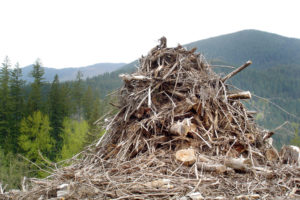Biomass energy is inadvertently making the climate crisis worse.
 In the lowland forests of the American southeast, loblolly pines and cypress trees are grabbing carbon dioxide from the air right now. Using power from the sun, they release the oxygen and bind the carbon, building trunks, barks, and leaves.
In the lowland forests of the American southeast, loblolly pines and cypress trees are grabbing carbon dioxide from the air right now. Using power from the sun, they release the oxygen and bind the carbon, building trunks, barks, and leaves.
But much of that carbon won’t stay there. As it turns out, millions of tons of wood from these forests each year are being shipped across the Atlantic, and burned in power plants in countries like the UK and the Netherlands, in the name of slowing climate change.
As they steadily wean themselves off coal, European Union nations are banking on wood energy, or “biomass,” to meet their obligations under the Paris climate agreement.
That’s because in 2009, the EU committed itself to 20 percent renewable energy by 2020, and put biomass on the renewables list. Several countries, like the United Kingdom, subsidized the biomass industry, creating a sudden market for wood not good enough for the timber industry. In the United States, Canada, and Eastern Europe, crooked trees, bark, treetops, and sawdust have been pulped, pressed into pellets, and heat-dried in kilns. By 2014, biomass accounted for 40 percent of the EU’s renewable energy, by far the largest source. By 2020, it’s projected to make up 60 percent, and the US plans to follow suit.
Fueling this boom is a simple, intuitive idea: that biomass is both renewable and “carbon neutral,” and a way to keep an economy built on burning fossil fuels humming along.
But a cadre of scientists and policy activists are now pushing back, saying that biomass energy rests on deceptive accounting. Rather than being carbon neutral, biomass is liquidating millions of tons of irreplaceable carbon stocks in the midst of a climate crisis already out of control.
Burning carbon to store carbon?
There are few bigger players in the biomass industry than Drax Group, whose flagship power plant in the north of England sucks up nearly a quarter of global wood pellet production, about two-thirds of it from the US. The UK has bought big into biomass, and Drax powers 10 percent of the British electric grid, in large part thanks to massive government subsidies: about $1.2 billion a year.
Burning wood in its former coal plants, said Drax CEO Andy Koss, means 80 percent savings in carbon dioxide when compared to coal. “And in 25 to 30 years’ time, we’re delivering carbon savings.”
The carbon neutrality argument of Drax and others in the wood pellet industry rests on a couple of ideas: first, that the carbon burned in the pellets can be brought back to Earth in the form of new trees; second, that the wood burned is industry waste that would be lost to the air anyway.
The American lumber industry still does a lot of clear-cutting, said Seth Ginther of the US Industrial Pellet Association, an industry group focused on the international trade, and the pellet market provides a market for wood that would be cut anyway, but would otherwise just be left in a field to slowly evaporate, or be burned for waste.
“There was no universe,” he said, in which any sensible landowner was just going to leave a valuable resource like a forest standing, not earning money. But this way, Ginther said, landowners allow power plants like Drax to replace coal with a fuel source that, once used, can be regrown.
The biomass industry, Koss argues, isn’t driving clear-cutting so much as making use of its waste. “Clear cut is the traditional method of harvesting a forest. So it’s not biomass that drives whether forest is clear-cut or not; most foresters will tell you it’s the best way to get regrowth to come back, and that it’s good for biodiversity across a managed landscape.” The way the pellet industry sees it, by clearing dead wood that slows the growth of a forest, biomass “puts more carbon in the bank,” as Benedict McAleenan, spokesperson of Biomass UK, a British trade group, put it.
An even bigger argument for biomass, according to the industry, is the forestry maxim that “the forest that pays, stays.” By providing a new market to rural foresters who once depended on a dying pulp and paper industry, they create, Ginther said, “the difference between planting more trees and converting their land to something else.”
Koss said forest owners he talks to “often tell me that if it wasn’t for Drax or [its supplier] Enviva, I’d be turning this land into a Walmart.”
